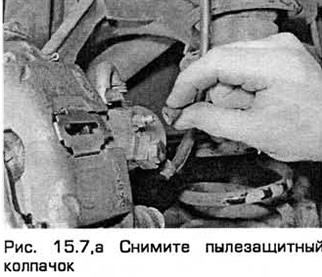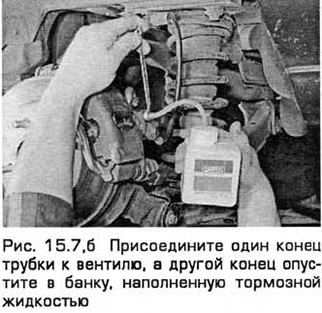Warning: Brake fluid is dangerous. If it comes in contact with your skin, wash it off immediately and if it gets into your eyes, seek medical attention. Brake fluid damages paintwork and plastics. If liquid comes into contact with such surfaces, immediately wash it off with plenty of clean water.
1. If the master cylinder was removed and then reinstalled and connected to the pipeline, then you need to remove air from the entire system (from both circuits). If a component of one of the circuits has been removed, then only the corresponding circuit must be bled.
2. Bleeding should start with the front brake. Then you need to pump the rear brake, located diagonally relative to the pumped front. Then you need to pump the other front brake and after that the other rear.
3. Bleeding kits are available at auto supply stores to allow you to bleed the air yourself without assistance. Follow the kit manufacturer's instructions. If you use such a set, then when performing pumping, you do not need to keep the brake pedal depressed.
4. When pumping, the level of brake fluid in the reservoir should not fall below the mark "minimum". If the level has dropped so that air has entered the system, then the entire bleeding procedure must be performed again. Always add only fresh brake fluid to the system.
5. Before starting work, check the condition of pipelines and hoses, as well as the tightness of the connections. Do not let brake fluid come into contact with the paintwork, otherwise it may be damaged. Wash off immediately with cold water.
6. If you are not using a bleed kit, then prepare a clean jar, a piece of plastic or rubber tube to be pulled over the bleed valve, as well as a canister of brake fluid of the appropriate brand and capacity. You will also need an assistant.
7. Clean the surfaces around the bleed valve on the front brake. Remove the dust cap. Attach one end of the tube to the valve, and dip the other end into a jar filled with brake fluid (see fig.15.7,a,b).


8. Turn off the valve one or two turns and ask the assistant to squeeze the brake pedal to the pop. Tighten the bleed valve with the pedal fully depressed, then have an assistant release the pedal. Continue this procedure until clean brake fluid without air bubbles flows from the tube into the can. Finally, tighten the bleed valve with the pedal fully depressed.
9. Remove the tube and install the dust cap. If necessary, add brake fluid to the reserve tank.
10. Repeat the procedure in the sequence indicated in paragraph 2.
11. Check: the pedal should become tight. If she "soft", which means that air remains in the system and it must be pumped again.
12. Upon completion of pumping, add liquid to the reserve tank and install the cap.
13. On models with a hydraulic clutch, check the operation of the hydraulic system and, if necessary, remove air from it (paragraph 6).
Visitor comments